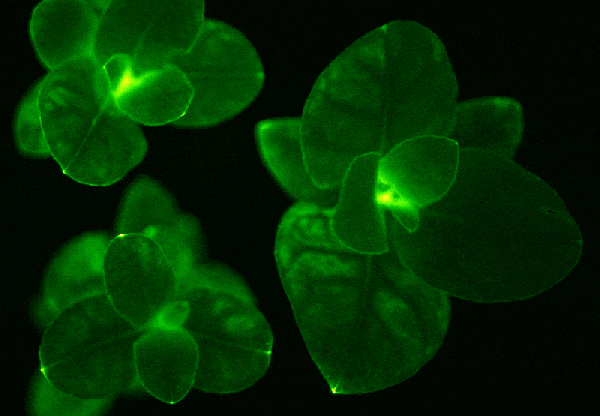Bioluminescence, Fluorescence, and Glow-in-the-Dark Life
By Madison Kasten
When asked to imagine an enchanted forest, a common feature would be the soft glow provided by the plant life, and perhaps even some mystical animals, that would call the forest home. While we don’t yet have a way to recreate these glowing forests without photoshop and some impressive artificial lighting, gene-editing technology has been used to create special versions of petunias and multiple types of fish that are able to glow like something straight out of a fantasy novel (with none of the magic required!).
These special flowers, called Firefly Petunias, are similar to a standard white petunia (petunia hybrida) during the day, but the firefly variants also have a unique soft, green glow during the night. Unlike what their name suggests, however, the new genes present in the Firefly Petunias that give them their signature glow do not come from fireflies, rather, they come from a species of glowing mushroom. Instead, the name Firefly Petunia more likely comes from the fact that the chemical responsible for the flower’s green glow is luciferin, a chemical that is also produced by fireflies.
How do these mushroom genes lead to the production of luciferin in a flower? The answer is through a reaction involving caffeic acid, which is a molecule the petunia naturally produces. To understand how the addition of a few genes results in a chemical reaction, we first need to understand exactly what the genes do.
The genes that were present in the mushroom that were later added to the firefly petunias instruct the cells of the organism to produce specific enzymes. An enzyme is a protein whose job is to assist in a reaction that would either occur very slowly or not occur at all if the enzyme was not present. Enzymes complete this function by attaching to one molecule, called the substrate, and assist in the chemical reaction necessary to convert the substrate into a different molecule, called the product. The enzymes present in both the mushroom and Firefly Petunias are responsible for assisting in the chemical reaction that converts the caffeic acid that naturally occurs in the petunias into the molecule luciferin.
In addition to enzymes being required to produce the molecule required to make the plant glow, they are also responsible for facilitating the reaction that causes the glow. Luciferin itself will not cause the glow that the Firefly Petunias are known for. Instead, a specific kind of enzyme called a luciferase assists in a chemical reaction to combine luciferin and oxygen to produce an oxidized luciferin molecule and light. The light produced by this reaction is what gives the flower its signature green glow, while the oxidized luciferin can be converted back into caffeic acid which would continue the cycle.
 Not all organisms are able to produce their own light though. While Firefly Petunias are able to glow through bioluminescence, which means they are capable of generating their own light without any outside source, the glowing fish that are often found in pet stores (called GloFish) glow through a different process called fluorescence. Unlike bioluminescence, fluorescence requires an outside source of light for the glow to be seen. In other words, fluorescent organisms reemit light instead of generating it.
Not all organisms are able to produce their own light though. While Firefly Petunias are able to glow through bioluminescence, which means they are capable of generating their own light without any outside source, the glowing fish that are often found in pet stores (called GloFish) glow through a different process called fluorescence. Unlike bioluminescence, fluorescence requires an outside source of light for the glow to be seen. In other words, fluorescent organisms reemit light instead of generating it.
Fluorescence also relies on a different process to achieve a similar glowing effect. Instead of relying on an enzyme to facilitate a light-generating chemical reaction, the genes used in GloFish generate fluorescent proteins. The role of these proteins is to absorb light and reemit it. As the light is absorbed and reemitted by the protein, the light changes color. This is how the ultraviolet light the fish are exposed to is transformed into the multiple glowing colors the fish are sold in.
As you can see, even a seemingly simple Glow-in-the-dark effect can require a few intricate parts to become a reality. Once you take some time to focus on how the different parts of the process work, however, you see how they can be just as interesting as the overall effect. So, as you continue to hear about all of the interesting new things that technology has to offer, keep in mind that the seemingly magical effects are the result of some even cooler science.
